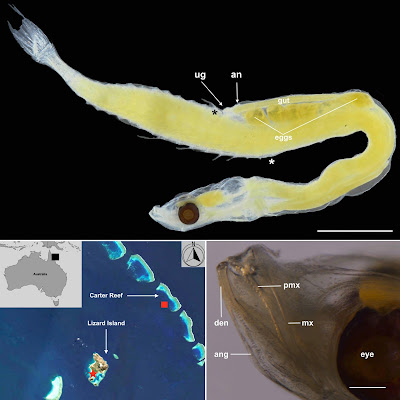 |
| Schindleria nana Ahnelt, Macek & Robitzch, 2024 DOI: 10.25225/jvb.23112 |
Abstract
Here, we describe a new species of Schindleria, Schindleria nana, from Lizard Island, Great Barrier Reef, Australia. The new species belongs to the long dorsal-fin type (LDF) of Schindleria and is the first very small (‘dwarf’) LDF species (< 13 mm TL) to be described. It is characterized by an elongate and narrow body; a dorsal fin longer than the anal fin (predorsal-fin length 63.3% of SL: preanal-fin length 72.1% of SL); a long, relatively narrow head (head width 46.2% of head length) with a straight profile; small and round eyes (24.9% of head length); a large postorbital distance (52% of head length); a narrow, slender pectoral radial plate (width at origin 46.4%, maximum width 57.0% of pectoral radial plate length); 16 dorsal-fin rays; 11-12 anal-fin rays; first anal-fin ray ventral to the sixth dorsal-fin ray; six procurrent rays gradually increasing in length, last ray elongated, twice the length of the penultimate ray; premaxilla with tiny, conical, densely set teeth; dentary with zero teeth in the holotype and with two teeth on the left dentary and five teeth on the right dentary in the adult paratype; females with few (approx. 4-7) but very large eggs (3.4-3.9% of SL); urogenital papilla inconspicuous, de facto just an urogenital opening; swim bladder not pigmented; black eyes; no other external pigmentation on the body.
KEYWORDS: Coral reefs, Indo-Pacific, Miniaturization, new species, progenesis, taxonomy
Schindleria nana
Diagnosis: The new species S. nana stands out from its congeners because it is the first small-sized species (< 10 mm SL) in the LDF species group and the first LDF Schindleria with only a few (4-7) and very large eggs (3.1-3.6% of SL) (Figs. 3, 4A). It differs from its congeners in the combination of the following characters: body elongated, slender, and not pigmented in preserved specimens; tail (postabdominal region) distinctly shorter than abdomen; origin of the dorsal fin distinctly anterior to origin of the anal fin (LDF type); predorsal-fin length 63.1-63.5% of SL; preanal-fin length 71.2-73.0% of SL; body depth at the origin of the anal-fin 5.9-6.6% of SL; head length 14.4-15.6% of SL; head depth 7.8-8.1% of SL; eye diameter 3.3-3.6% of SL and 23.1-26.1% of the head length; pectoral radial plate length 5.6-5.8% of SL; maximum width of the pectoral radial plate 3.2-3.3% of SL and 56.9-57.1% of pectoral radial plate length; depth of the hypural late 66.7% of the urostyle length; 16 dorsal-fin rays; 13 anal-fin rays, first anal-fin ray positioned below the 5-6th dorsal-fin ray; six procurrent rays; swim-bladder not pigmented; continuous row of small, conical teeth on premaxillary but zero teeth on the dentary of the holotype or five teeth (right) plus two isolated teeth (left) in the dentary of the paratype. ....
Etymology: The specific name ‘nana’ (from the Latin ‘nanus’ – dwarf) refers to the small size of this species.
Harald Ahnelt, Oliver Macek and Vanessa Robitzch. 2024. Schindleria nana, A New extremely progenetic gobiid fish Species (Teleostei: Gobiiformes: Gobiidae) from Lizard Island, Great Barrier Reef, Australia. J. of Vertebrate Biology. 73: 23112.1-17. DOI: 10.25225/jvb.23112
